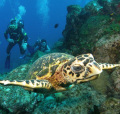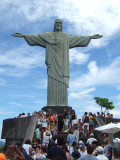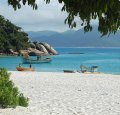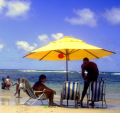Southeast
 Friday, February 5, 2010 at 03:57PM
Friday, February 5, 2010 at 03:57PM The Southeast Region of Brazil includes the states of Espírito Santo, Minas Gerais, Rio de Janeiro and São Paulo. It is the richest region of the country. From a tourist perspective the area is rich in history and culture. It also has magnificent coastlines, areas of natural beauty, national parks and famous cities with iconic attractions such as Sugar Loaf Mountain and the statue of Christ the Redeemer in Rio de Janeiro guide.
Rio Guide
Rio de Janeiro ("River of January") is the first tourist destination, second largest city, and third largest metropolitan area in Brazil. It is also the capital city of the state of same name and was the capital of Brazil until 1960, when the capital was moved to Brasilia. It is popularly known as just Rio and has the nickname A Cidade Maravilhosa, or "The Marvelous City."
Rio de Janeiro is famous for its natural settings, its Carnival celebrations, samba and bossa nova music. It´s hotel-lined tourist beaches, such as Copacabana and Ipanema are also world famous. In addition to the beaches, the other most famous landmarks include the giant statue of Christ, known as Christ the Redeemer ('Cristo Redentor') atop Corcovado mountain, named one of the new Wonders of the World; Sugarloaf Mountain (Pão de Açúcar) with its cable car, and the Maracanã stadium, one of the world's largest futbol stadiums.
The city also boasts the largest and second largest urban forests in the world: Floresta da Tijuca, or "Tijuca Forest", and (almost connected to the first) the forest in Parque Estadual da Pedra Branca, or "White Stone State Park."
Despite its charm and beauty, Rio is also famous as being one of the most violent cities in the world, with portrayals of this problem in movies such as Bus 174, City of God and Elite Squad. Much of the violent crime is concentrated in the favelas or shantytowns, but it also spills into middle- and upper-income neighborhoods, and tourists should ideally be streetwise or have a good guide.
Close to Rio are other major tourist destinations: the historic city of Petropolis, known as The Imperial City of Brazil home to the former Summer Palace of the second Brazilian Emperor; the luxury destination Bouzios, a chic resort in a former fishing village make famous in the 60´s by Brigitte Bardot or Paraty, an unspoilt fishing village with cobble stone streets and ornate churches that reflect its importance as the principle port of the colonial gold trade. These, and other similar destinations, will also be covered in the Rio Guide.
São Paulo Guide
São Paulo is the largest city in Brazil and is among the seven largest metropolitan regions of the world. It is also the capital of the State of São Paulo, the most populous Brazilian state and the richest city of Brazil. It is the financial capital of Brazil, and arguably of Latin America, and also a capital of culture in terms of the arts and entertainment.
The city itself has some attraction for tourists, but the state of São Paulo has far more, such as the largest remaining area of the Brazilian Atlantic Forest, the Ribeira Valley, now a UNESCO Natural Heritage of Humanity destination as a Biosphere Reserve. It is attractive as one of he biggest and most diverse ecosystems, with approximately 400 species of birds, amphibians, reptiles and mammals. The Alto Ribeira Touristic State Park (PETAR) is a paradise for ecotourists, in terms of its natural assets and important geolocical formations; caves, rivers, revines and waterfalls. There are 454 registered caves according to the Brazilian Society of Speleology (SBE) and 280 are located in PETAR making it the biggest concentration of caves in Brazil.
São Paulo Guide will cover the attractions in the city and the state.
Belo Horizonte Guide
Belo Horizonte ("Beautiful Horizon") is the capital of the state of Minas Gerais. It was founded in the early 1700´s, but the city as it is today was planned and constructed in the 1890s. It replaced Ouro Preto as the capital of the state. It is known for the contrast between contemporary and classical buildings.
Surrounding the city are several parks with large areas of native forest including the Mata do Jambeiro nature reserve, with over 900 hectares of Atlantic Forest and more than one hundred species of birds.
Belo Horizonte has a large production and distribution centre that serves the region's mines and industries. Mining was a major activity, even in the colonial times, and the city is surrounded byold colonial towns like Vila Rica do Ouro Preto ("Rich Village of the Black Gold"), located in the Serra do Espinhaço mountains and designated as aWorld Heritage Site by UNESCO because of its outstanding Baroque architecture.
Belo Horizonte Guide will be a guide to the city and all the surrounding tourist attractions.












